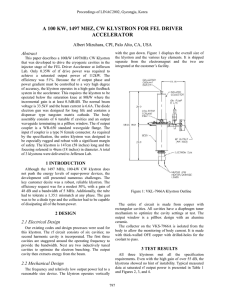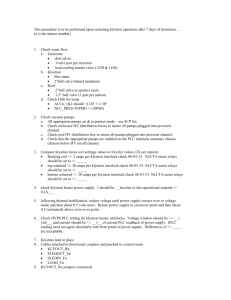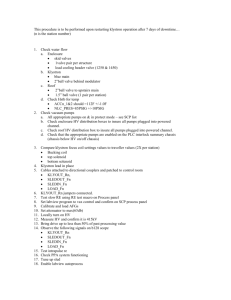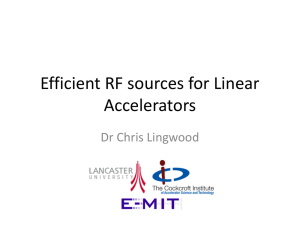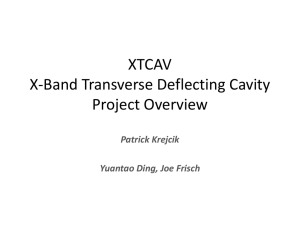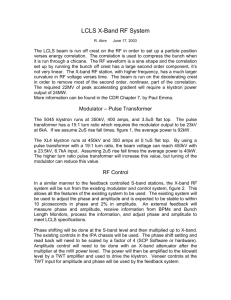Titre aliquando tempo tatum commentum
advertisement
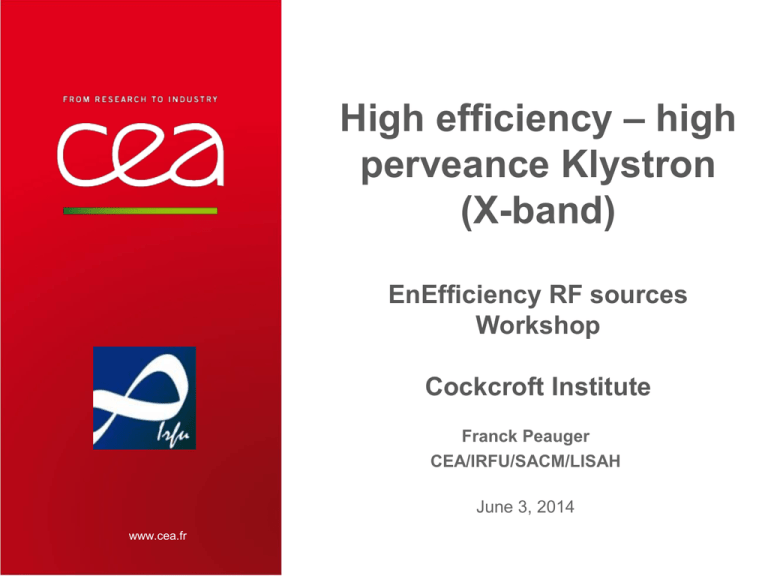
High efficiency – high perveance Klystron (X-band) EnEfficiency RF sources Workshop Cockcroft Institute Franck Peauger CEA/IRFU/SACM/LISAH June 3, 2014 www.cea.fr www.cea.fr OUTLINE Context and objectives New klystron concept Simulation codes Klystron development plan 2 Context and objectives New klystron concept Simulation codes Klystron development plan 3 WORK DONE UNDER TASK 12.3 OF EUCARD2 WP12 Innovative RF Technologies 2013 - 2017 « In this sub-task, CEA will develop and search for innovative concepts of X band RF power sources and components. The objective is to propose affordable and reliable solutions for future testing capabilities for the CLIC accelerating structures. The task includes the design and the fabrication of prototype RF devices to demonstrate the feasibility of the new concepts proposed. » Juliette PLOUIN: CEA project leader for this sub-task Budget available to build a (small) part of the RF power source or component Fully oriented towards an R&D activity 4 A STRONG MOTIVATION WITH A MORE GENERAL INTEREST • Some important projects (XFEL, ESS, CLIC-drive beam, FCC…) search for “green technologies” and so require ultra-high efficiency RF sources • Modulators are now close to 90% efficiency. Microwave tubes are one of the major weak point in the energy consumption chain • A road map to reach the 90% efficiency horizon have been established by Igor at different frequencies • Our Eucard2 task is well in agreement with this road map • This project is also an occasion to acquire knowledge and experience on RF sources “in-lab design” and why not “in-lab fabrication” in Europe (like what is done at SLAC or on HV modulator at CERN for example) 5 LIST OF POSSIBLE DEVICES Microwave vacuum tubes for X band and high peak power O type tubes Carcinotron Travelling wave tube Klystron Single beam klystron Multibeam klystron Sheet beam klystron Hollow beam klystron Gyro devices M type tubes Gridded tubes Gyroklystron Locked Magnetron IOT “affordable and reliable” = reduced surface fields (DC and RF) “high efficiency” = Optimal beam / RF interaction 6 • • • Development started in 80’s for linear collider studies at SLAC XC series: 100 MW design, 65 to 72 MW measured XL series for NLCTA: 50 MW, 410 kV – 305 A, reduced perveance of 1.2µA/V1.5, 40% efficiency, • XL4 : 11.424 GHz produced in 15 units • PPM focusing investigated and combined with high efficiency (60%) but with limited success • In 2008 – 2011: XL5 : scaling of XL4 at 11.9942 GHz for CLIC, PSI and Trieste - 5 tubes built • Since 2011: XL5 transferred to industry : CPI VKX8311A - first tube tested at SLAC in 2013 Image: courtesy of SLAC, E. Jongewaard X-BAND 50/75 MW KLYSTRON (USA) 7 N. Catalan, CLIC workshop 2014 X-BAND 75 MW KLYSTRON (JAPAN) Same parallel development at KEK/TOSHIBA for NLC/JLC Spec (target): 75 MW, µPerv. 0.8, 60% efficiency More results with the PPM focusing version 10 tubes tested S. Fukuda, KEK, 2005 Image: courtesy of TOSHIBA 8 X-BAND 150 MW MULTIBEAM KLYSTRON (JAPAN) Annular cavities working on a HOM “Realistic design” to reduce the beam voltage A. Larionov et al., KEK 9 9.3 GHZ – MEDIUM POWER « COMMERCIAL » KLYSTRON 10 SHEET BEAM KLYSTRON Explored in W-band, S-band and at 1.3 GHz by SLAC PPM focused X-band tube under development at CPI to lower the voltage Also investigated in China at IECAS A. Jensen, SLAC, IVEC2013 T. Johns et al., CPI 11 D. Zhao et al., IECAS ANNULAR BEAM KLYSTRON Developed by CCR at 1.3 GHz – 10 MW Very high perveance (3.3 µA/V^1.5) and high efficiency (65%) Zero compression gun and high current density cathod Try to avoid diocotron instabilities M. Read et al., CCR 12 XBOX3 TEST STAND AT CERN XBOX3 will use four Medium Power X-band klystrons recombined and compressed to produce a 50 MW power level This smart concept is well adapted to the reliability and affordability we are looking for and it will constitute the basis of our study I. Syratchev, G. McMonagle, N. Catalan Lasheras Medium power x-band RF sources medical applications • 4 turn-key 6 MW, 11.9942 GHz, 400Hz power station (klystron/modulator) have been ordered from industry have also a wider interest into FEL • The first unit is scheduled arriveand at CERN in Octob 2014. The full delivery will be completed before13July 2015. XBOX 3 AT CERN CERN is ordering commercial products for XBOX3 (4 units of each) No particular R&D is required and delivery time is short TOSHIBA klystrons parameters Peak power: 6 MW Beam Voltage: 150 kV Beam current: 90 A Average power: 12.4 kW Efficiency: 47.5% SCANDINOVA Modulator parameters Peak RF power: 8.0 MW Pulsed voltage: 175 kV Pulse current: 115 A Average power: 50 kW Pulse length (flat): 5 sec Rep. rate: 400 Hz 14 A VERY CHALLENGING OBJECTIVE Our proposal is to study and design a 12 GHz single beam klystron able to deliver a peak power of 12 MW with a pulse duration of 4.5 s to double the testing capability of XBOX3 It should be compatible with the Scandinova modulator ordered for XBOX3 in order to do fully qualify the klystron at CERN. A possible operating point could be: - Vk = 170 kV - Ik = 100 A -> µP = 1.4 µA/V1.5 - efficiency > 70 % -> Pout = 12 MW A new klystron concept is required P. Guidee, Thales, 2001 A classical solenoid based focusing system would be considered for this first step. The klystron should be designed to operate at a pulse repetition rate of 400 Hz minimum and - why not 15 -, up to 1 kHz, a highly interesting repetition frequency for future FEL projects Context and objectives New klystron concept Simulation codes Klystron development plan 16 THE ADIABATIC CONCEPT A system is called adiabatic when the external forces vary more slowly than the interaction forces in the system. The dynamics of the system is then a succession of equilibrium states and the entropy does not increase. Example in thermodynamic: adiabatic if no heat exchange with the external medium: the piston velocity must be smaller than the speed of sound in the gas In our case, the external forces are the beam induced bunching forces and the interaction forces are the space charge forces. 17 A PARALLEL WITH RFQS FOR PROTON LINAC An RFQ cavity is used in proton linac injector to bunch, focus and accelerate a continuous beam from few tens of keV to few MeV. It allows a beam transport in space charge regime (high intensity beams is possible) with very low beam losses. TE210 mode longitudinal modulation on the electrodes creates a longitudinal component in the TE mode that bunch and accelerate the beam bl In the IPHI RFQ (3 MeV, 6m, 352 MHz), around 350 cells are used to bunch the beam 18 PHASE SPACE DISTRIBUTION IN AN RFQ Along the 6m RFQ: Energy dispersion dW (MeV) At the RFQ exit: Phase (deg) The bunching process in an RFQ is adiabatic (« gentle » buncher) The RFQ preserve the beam quality, has a high capture (~90%) compare to a discrete bunching model (50%) 19 INCREASING THE NUMBER OF CAVITIES IN A KLYSTRON 10 cavities Efficiency 67.2 % Length 197 mm 20 cavities Efficiency 78 % Length 285 mm The idea is also to maintain a classical perveance value of 1.4 µA/V1.5 (170 kV – 100 A) : high current leads to shorter plasma wavelengths (and so shorter structures) In the design proposed, the cavities are weakly coupled to the beam (low R/Q) and largely detuned to avoid strong bunching 20 ANIMATION FROM AJDISK RESULTS (CHIARA MARRELLI) 5 cavities – 1 GHz optimized by C. Marrelli 𝜇Perveance = 0.21 Pout ≈ 2.3 MW Efficiency 78. % 20 cavities – 12 GHz optimized by F. Peauger 𝜇Perveance = 1.4 Pout ≈ 12.5 MW Efficiency 78 % EXPECTED PERFORMANCES WITH 4 DIFFERENT DESIGNS Name Numbers of cavities R/Q [Ohm] TTF Efficiency Overall length [mm] AK10-2 10 20 to 50 0.683 67.2 % 197 AK14-1 14 20 0.683 68.5 % 221 AK20-3 20 27.4 0.688 74 % 285 AK20 20 12 0.72 78 % 285 70% efficiency These design have been manually optimized and could be certainly fully improved by an automatic procedure. 22 EXPECTED DETAILED PERFORMANCES 14 CAVITIES STRUCTURE Output power for different cathod voltages Phase variation for 1% of cathod voltage change 14 175 kV – 104 A Output phase (deg) Output power (MW) 12 170 kV – 100 A 10 8 150 kV – 82.8 A 6 4 125 kV – 63 A 2 -50 -55 -60 -65 -70 -75 -80 -85 -90 -95 -100 ∆∅ ∆𝑉𝑘 0 10 20 Input power (W) 30 171.7 kV – 101.5 A 170 kV – 100 A 168.3 kV – 98.5 A 0 0 =9.4 °/kV 5 40 10 Input power (W) Bandwidth 80 74 70 70 60 66 Gain (dB) Efficiency at saturation (%) Efficiency at saturation for different cathod voltage 50 40 20 50 11.97 140 150 160 Cathod voltage (kV) 170 180 Small signal (Pin = 0.5 W) Saturation (Pin = 10 W) 58 54 130 170 kV – 100 A 62 30 120 15 11.98 11.99 12 12.01 12.02 Drive frequency (GHz) 12.03 23 BUNCHING CAVITY DESIGN E z ( z ) dz R Q 2U 2 M E j z ( z )e z b C dz L/2 E z ( z ) dz L / 2 Eigenmode F = 11.9108 GHz, Q = 2039 with copper Utot = 2.5735E-19 J R/Q = 23.9 ohm M = 0.6127 XY Plot 1 cav3 0.20 Curve Info ComplexMag_E Setup1 : LastAdaptive gap2='1mm' Phase='0deg' r1='9mm' ComplexMag_E_1 Setup1 : LastAdaptive gap2='1mm' Phase='0deg' r1='9mm' 0.18 0.15 Y1 [V_per_meter] 0.13 0.10 0.08 0.05 0.03 0.00 0.00 5.00 10.00 15.00 20.00 25.00 Distance [mm] 24 INPUT / OUTPUT CAVITY DESIGN Input cavity Qx = 460 Output cavity: many possibilities: - Same as input cavities but with Qx = 20 (change of the iris dimensions) - Multicell output cavity: SW or TW - Other ideas ? (backward wave, recirculation, …) SLAC XL5 output cavity (4 cells, p mode) 25 Context and objectives New klystron concept Simulation codes Klystron development plan 26 BEAM / RF INTERACTION SIMULATION TOOLS AJDISK (SLAC) 1D free ? Frequency domain 2D MAGIC TRACEWIN PIC time domain 2D/3D (CEA) Tracking 2D/3D Cluster CST Preliminary design Design consolidation PIC time domain 3D WARP (LBNL) PIC time domain 2D/3D Free, open source Cluster Emittance growth, matching, halo and error studies (new use for klystron!) Full verification of the performances and oscillation study 27 THE WARP CODE Warp*: PIC modeling of beams, accelerators, plasmas Lawrence Berkeley National Laboratory, CA, USA 28 SIMULATING A MONOTRON CASE WITH WARP Monotron oscillator = most simple microwave tube configuration A well know phenomena (most of the time not desired) in the microwave tube community DC energy source + resonant system = monotron Objective: validate WARP on its ability to simulate the beam/RF interaction where Barroso publication: 20 kV – 10 A, annular beam, two-steps cavity 4.1 GHz 1D analytical treatment is possible and 2D PIC results is compared 29 MONOTRON CASE Barroso publication • Without focusing magnetic field Bz WARP simulation 10 ns 630 ns > 750 ns Simulations performed by Antoine Chancé - CEA 30 MONOTRON CASE Barroso publication • With focusing magnetic field Bz WARP simulation 10 ns 542 ns > 750 ns 31 MONOTRON CASE Ez field at saturation WARP simulation 4.1 GHz Barroso publication Ez field at saturation at r = 7 mm The WARP code is valid for simulating all kind of vacuum microwave tubes 32 TRACKING CODE “TRACEWIN” a 3D code widely used in the accelerator community PARTRAN routine to simulate the space charge effects The idea is to inject the gap voltages calculated by AJDISK Allows to simulate a large number of particles (useful for Halo studies for example) and has automatic optimization procedures 33 Context and objectives New klystron concept Simulation codes Klystron development plan 34 THE 12 GHZ - 12 MW KLYSTRON PROTOTYPE PLANNING 2014 2015 2016 Preliminary design 2017 Commissioning preparation (advanced simulations) Detailed design and drawings Convergence on simulation codes Fabrication Choice of the number of cavities Design Review Tests Superconducting solenoid PhD student 35 TOWARDS HIGHER EFFICIENCY WITH THE ADIABATIC APPROACH Tentative Road map Medium Power klystron High power klystron 170 kV – 12 MW single beam 170 kV – 50 MW 4 beams Advanced Focusing system: superconducting solenoid / Permanent magnet / RF focusing?... Output RF structure: SW, TW, … Proof of principle Low power klystron 60 kV (gun in air) 1 MW single beam or 4 to 6 MW multibeam X-band frequency Lower frequency klystron 1 GHz, 704 MHz or lower Directly applicable to accelerator projects (ESS, CLIC, FCC…) FABRICATION: collaboration with industry is mandatory: Higher frequency klystron > 12 GHz To check the limit of the concept Need to find some applications Possible strategy: • Functional drawings by lab (CEA or CERN) • Call for tender for the fabrication of one prototype NEW PROCEDURE for klystrons (but usual for Gyrotron in the fusion community) 36 CONCLUSION o Some clear and highly motivating objectives to develop high efficiency RF sources with high reliability have been presented o The new adiabatic approach to optimize the bunching process of the beam have been proposed and declined in few designs Kl-adi(adiabatic)-stron = « KLADISTRON » o We are working on new numerical tools for the klystron study o We have also to think of extending the Eucard2 project to a larger collaboration 37 CEA TEAM CEA permanent staff Post-doctoral position 24 months from April 2014 Modelisation of the beam/wave interaction Franck PEAUGER Juliette PLOUIN Barbara DALENA Funding EUCARD2/CEA Internship with help of: 6 months from April 2014 Design of electron guns Antoine CHANCÉ Beam dynamics, user of Tracewin and Warp Lyes BOUDJAOUI Funding CEA + 1 PhD position with funding demand in progress http://www-instn.cea.fr/spip.php?page=Publication_Sujet&idSujet=8343&lang=fr&langue=fr&id_rubrique=70 38 EXTERNAL CONTACTS FOR POSSIBLE COLLABORATIONS CERN/CI: Igor SYRATCHEV, Chiara MARELLI, … THALES ELECTRON DEVICES: Rodolphe MARCHESIN, Armel BEUNAS PSI: Jean Yves RAGUIN, Micha DELHER New collaborators are WELCOME! 39 EXTRA SLIDES 40 WHAT IS A KLYSTRON? Image: courtesy of Thales Electron Devices It is a vacuum microwave electron tube amplifier where: The input cavity prebunch slightly a DC beam provided by an electron gun The intermediate cavities develop an RF voltage induced by the beam loading (image charges). These induced voltage intensify the bunching process. The beam is strongly decelerated in the output cavity and a high RF power is created The decelerated beam is collected in a collector The beam is focused by an axial magnetic field (solenoid) Image charges RF out Axial electron velocity RF in 41 S. Berger - Thales, XB2008 workshop, Cockcroft Institute, UK THE CLASSICAL WAY TO DESIGN A KLYSTRON One or two cavities around central frequency to ensure the bandwidth Two or three bunching cavities at higher frequency, located at approximately a quarter of the reduced plasma wavelength lq 𝑉 0.75 ∙ 𝑏 𝜆𝑝 = 0.036 𝐼0.5 with b beam radius 𝜆𝑞 = 𝜆𝑝/𝐹 Exemple: Vk=170 kV, Ik = 85 A b = 1.8 mm, a = 3.5 mm lp = 59 mm ge .b = 0.61 rad F = 0.35 lq = 168.5, lq/4 = 42 mm At Ik = 1.5 x 85 A = 136 A, lq/4 is decreased to ~ 33 mm Beck, « Space Charge Wave », 1958, p.106 Maximize the modulated current I1/I0 Sometimes a 2nd harmonic is added to reduce the length of the interaction structure 42 A CLASSICAL 6 CAVITIES KLYSTRON Quick design with AJDISK (SLAC 1D code) 20 mm 46 mm 55 mm Drift lengths ~ lq/4 Large energy dispersion Limit of the method: induce large velocity dispersion and so limit the interaction efficiency (except for very low perveance and/or advanced optimization method – cf Baikov, Guzolov et al.) 43 GLOBAL COMPARISON WITH OTHER METHOD (IGOR SYRATCHEV) 44
